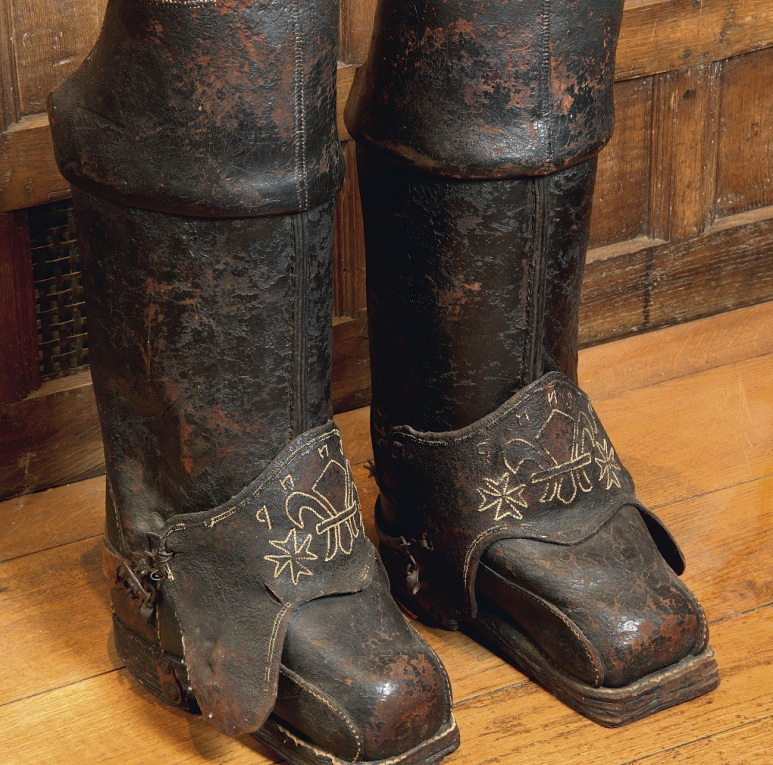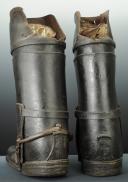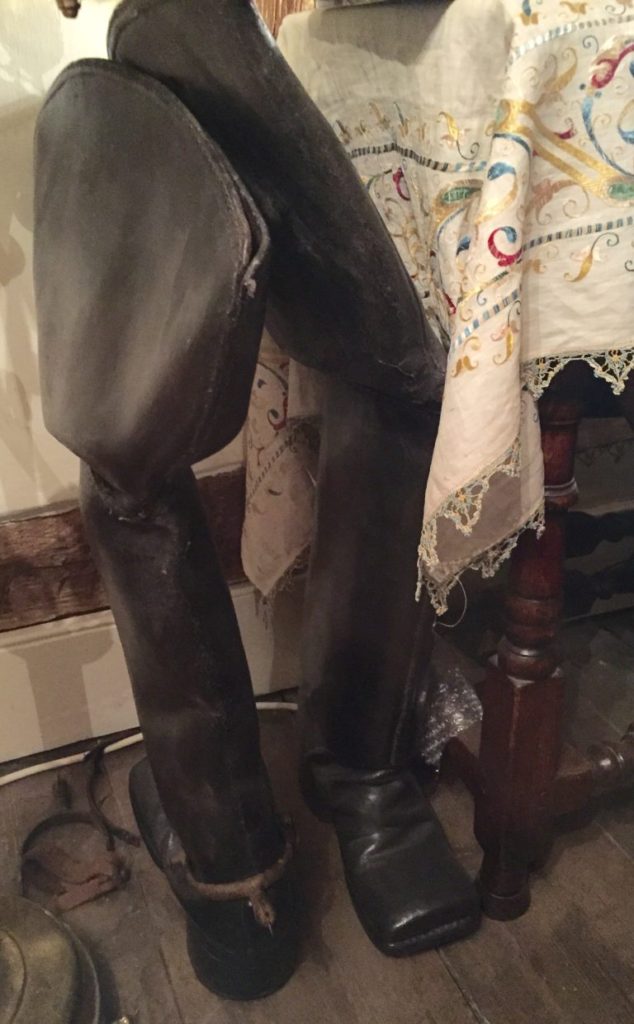by Kristine Hughes Patrone

On a recent visit to Hever Castle, I met with this formidable pair of “postilion boots” and decided that I had to find out more about the history of this footwear. Here, I share with you what I learned. First, from the Hever Castle website:
“The large leather and iron postilion’s boots date from 1690. A postilion was a man who rode one of a pair of horses that pulled a coach. It could be very dangerous if a leg became caught between the two horses, so each postilion wore one boot on that leg to protect himself from injury.
“Postilion riders usually rode the left horse of a pair and this style of travel was known as ‘posting’. Before the days of railways posting was the best method of travelling in England and on the Continent. Travellers would hire a private carriage from a postmaster. In England the postmasters were usually hotel keepers, and not employed by the Government. The carriage would travel from one posthouse to the next, where the postilions and/or horses could be replaced if necessary. Ordinarily a carriage was only taken on the main road, from one station to another. However, arrangements could be made to go off of the main road to a country house.”
Here are examples of postilion riders escorting carriages of various styles –




Above is the rear view of a pair of French postilion boots from the second half of the 18th century that I found on the website of military antiquarian Bertrand Malvaux. The description reads – “Black oiled leather with reinforced knees. Foot decorated with a cotton seam representing scrolls. One of these boots has still got its steel spur. Height: 56 cm; foot length : 32 cm.Very good condition (minor damage in the top part of boots). These surprising boots were used for postilions to protect their calves and knees from the shocks caused by the shaft of the coaches they drove. The wooden or leather sole was fixed onto the upper by pegs. It was curved so as to hold the stirrup on which it stood. These boots were called ‘the seven-league boots’. Indeed, at first, an average distance of seven leagues separated two staging posts.”
Finally, here is a bit on the distinction between postilion boots and the similar Marlborough jackboots, with further historical detail as to both, as found on Past Pleasures Ltd – Bringing History to Life:

“Here are a pair of my so-called ‘Marlborough’ jackboots, made somewhere between 1670 and 1712, according to the authority Miss June Swan of the Northampton Shoe Museum, which conserved them. (As my readers doubtless know, the midlands town was famous for its footwear. My family hail from there and for awhile owned a shoemaking factory; one of the regular customers was WG Grace for his cricket boots!).

“The massive cuffs at the knee would protect the wearer’s knees from an enemy on foot in a battle, as well as from thorns etc whilst out hunting. The high stacked leather heels not only follow the fashion of the period but also help to keep the feet firmly in the stirrups. On the underside you can see the leather pegs and hand-sewn details. The Square toes are a fashion that came about in about 1630 and died out about a hundred years later (thereafter the term ‘Old Square Toes’ was a derogatory remark).
“Unfortunately, although I have a pair of spurs of the period (not associated with the boots) I don’t have the distinctive ‘butterfly spur leathers’, the decorative shaped leather pieces worn at the instep.
“These boots are so stiff, heavy and strong they feel like they’re made of wood! They aren’t remotely supple and must’ve been hell to wear on foot –although the original owner would’ve changed into high-heeled buckled shoes as soon as he dismounted. And they would have been bespoke, so more comfortable. But heavy, and heavy-looking, as they are, they are not to be confused with ‘postilion boots’, those massive black leather boots you see in museums which were actually attached to the saddle, into which the post boy and/or postilion, riding one of the outside horses in a coach and four, would thrust his own booted legs.”